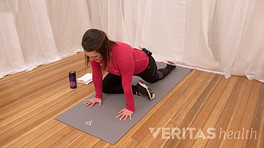Piriformis syndrome refers to spasms, tightness, or inflammation of the piriformis muscle, which can irritate the sciatic nerve and cause pain to travel through the buttocks and back of the leg. Stretching the piriformis muscle is almost always necessary to relieve the pain along the sciatic nerve, and can be done in several positions.
A number of stretches for the piriformis muscle, hamstring muscles, and hip extensor muscles can help decrease the painful sciatic leg symptoms and improve the patient’s range of motion.
Now we’ll perform the supine piriformis stretch. Lie on your back with your legs flat. Pull one knee up and grab your ankle with your opposite hand. Pull with that ankle so the knee is coming towards the opposite shoulder. As the knee comes up, make sure to pull the knee towards the shoulder rather than across your body. Try to keep your pelvis flat.
To modify the supine piriformis stretch, lie on your back with your legs flat. Cross one leg over the opposite knee and reach up grabbing your knee or your thigh, and pull it straight across your body.
Now we will perform the four-point piriformis stretch. Begin on all fours. Swing your ankles to one side. Using your outside leg, step straight back over the folded leg. Slide your hips back so your shoulder is coming towards the opposite knee.
To perform the knee to chest piriformis stretch, lie on your back with your legs flat. Cross one knee over the opposite knee and pull the lower knee up towards the shoulder on the same side. If you have difficulty reaching your arms around your legs, use a strap to assist you.











